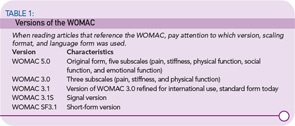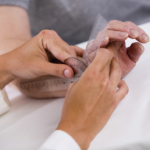Validation
In comparative analyses against performance-based measurement techniques, the WOMAC has frequently been superior in performance. Likewise, in comparisons against other disease-specific measures the WOMAC has compared favorably, and against generic health status measures has often been superior in responsiveness.5
Traditionally, OA clinical trial data are analyzed at the group level. Recently, attention has focused on individual patient-reported outcomes. These can be considered in two general forms: responder criteria, in which each patient is classified as a responder or nonresponder to treatment, based on whether their change in health status exceeds a predefined threshold; and state-attainment criteria, in which patients are classified on the basis of when, whether, and/or for how long they achieve a certain predefined level of low symptom severity.
WOMAC data have contributed significantly to the development of both response and state attainment criteria. (Download a list of WOMAC’s contributions to clinical criteria at www.The-Rheumatologist.org under “Download Issues.”)
Patient Participation, Focus Key
Patient involvement in estimating the clinical importance of improvement, and the acceptability of different levels of symptom severity is innovative, and meets the requirements for consumer involvement in decision making. The process also helps establish consumer-based definitions for response and state attainment in knee and hip OA.
An alternative method of benchmarking patients’ health status is against normative values derived from WOMAC items and estimated from a survey of the general population. The first such survey targeting 24,000 members of the general public has been completed, and data from a second survey, targeting a further 36,000 members, are currently being analyzed.8 Once completed, age- and gender-specific normative values based on items in the WOMAC NRS3.1 should be specified from about 7,500 subjects for pain and stiffness and about 13,000 subjects for physical function.
The International Classification of Function (ICF) proposed by World Health Organization provides a conceptual framework for health status assessment. An ICF core set has been described for OA, and the WOMAC successfully mapped to the ICF framework.9,10 A model has been developed for predicting utility scores that closely approximate those derived by direct measurement, which has important implications for health economic analyses.11
Collaboration Continues
The WOMAC also paved the way for rapid development of a comparable index for hand OA studies, termed the Australian/Canadian (AUSCAN 3.1) Hand Osteoarthritis Index.12 Like the WOMAC, the AUSCAN index is a tridimensional, self-completed, patient-centered health status questionnaire, encompassing pain, stiffness, and physical function.13 The AUSCAN Index contains five pain, one stiffness, and nine physical function items and has been validated in both five-point LK and 100-mm VA scaling formats; an 11-point NRS version is also available. The AUSCAN Index has been translated into 32 alternate-language versions, and is recognized in OARSI Guidelines for the conduct of clinical trials in hand OA. The concepts of OMERACT-OARSI Responder Criteria, AUSCAN 20-50-70 Responder Criteria, and BLISS (Pain) Index have recently been explored in hand OA patients, and appear applicable.14 For more information, visit www.auscan.org or www.womac.org.


